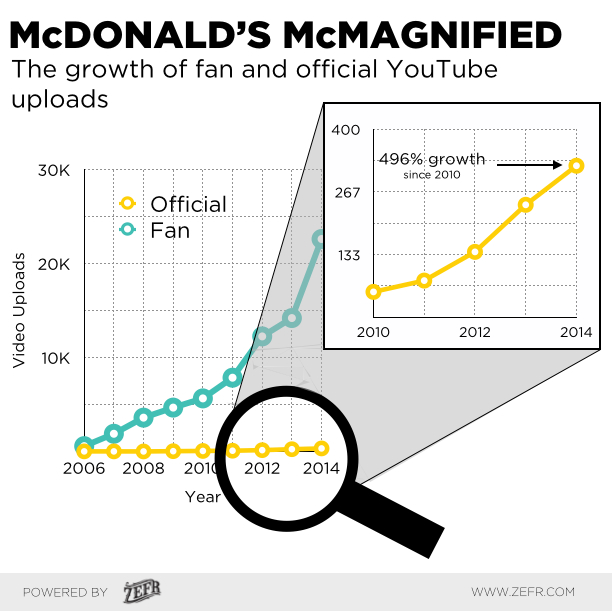January 30, 2015
Ever since Morgan Spurlock released the film Super Size Me in 2004 (along with the current rise of health food consciousness, driven in part by the success of Whole Foods and newer films such as Food, Inc. and Fed Up), McDonald’s has been fielding endless allegations about the ingredients of its food. The fast food giant has responded to the concerns of its consumers, calling out false accusations when they spot them and offering healthier choices at their restaurants. Yet the speculation continues. McDonald’s has finally gone on offense, simultaneously fending off consumer concerns with facts and reshaping their public image with a thoughtful new advertising campaign that boldly includes a strong social media presence, inviting conversations with the very customers they seek to win back.
In a recent video featured on AdWeek, McDonald’s CMO Deborah Wahl explains that, “McDonald’s is moving from a philosophy of billions served to billions heard.” The franchise is shifting their focus to look at customer concerns regarding the ingredients they put in their food. They have a working strategy in place to address them that largely focuses on the use of YouTube to get the message out. It even reaches as far as their conventional advertising, with a call to action to learn more about their menu on social media.
McDonald’s Embraces Social Media
McDonald’s has learned that the voice of the consumer will not be silenced, especially in the age of sharing information via social media (whether that information is true, false, or somewhere in between). They have taken action to address many of the accusations made against them in “Our food. Your questions,” a series of videos featured on their YouTube channel in which they answer fan questions by conducting walk-throughs from the factory to the store, showing how their food is made.
[youtube
They recruited “McDonald’s skeptic” Wes Bellamy to appear in the video above after he retweeted a photo he had seen of what the McRib supposedly looks like before it gets to the restaurant. After taking part, Bellamy took to his own Instagram feed to promote the video.
This is a smart move from McDonald’s. Using real fans in your advertisements is one way to demonstrate authenticity, but they go a step further, actually seeking out some of their harshest critics. By the end of the video Bellamy is not only more informed and enjoying his first McRib, he is eagerly anticipating a second helping.
A video responding to a consumer’s question can feel more authentic than a corporate icon responding to comments on Twitter. An actual person (Grant Imahara from MythBusters) is standing in as the consumer in these videos, questioning the McDonald’s employees at every stage in the process of food preparation. This, and the fact that fan-uploaded videos outnumber official McDonald’s uploads, is why YouTube is an essential component of the company’s campaign. McDonald’s understands that with platforms such as YouTube, their own message can get lost amidst the democracy of Internet.
McDonald’s has also utilized other social media sites to address questions from consumers. Although they do have some generic scripted responses, they are not afraid of showing a little personality that serves to humanize the company.
@katemillercny Like models, burgers experience lengthy photo shoots so styling techniques make them pretty, but we use the same ingredients.
— McDonald’s (@McDonalds) January 15, 2015
Conventional Advertising With A Twist
Along with the “behind-the-scenes” aspect of the campaign, McDonald’s has released new ads that indicate they’re focusing on the “Lovin’” aspect of their famous slogan, “I’m Lovin’ It.” Another conscious move on their part to engage in positive conversation about their products, redirecting attention to the real enjoyment their millions of customers experience daily.
The first of these is entitled “Archenemies” and features famous enemies, such as Dorothy and the Wicked Witch bonding over McDonald’s food.
[youtube
Though not everyone is a fan, rather than shy away from responding to negative comments on social media, McDonald’s has decided to “choose lovin’,” and directs any questions about ingredients to the previously mentioned video series.
@hanzala_h23 Hi there! One of our New Year’s Resolution’s was to put more Lovin’ in the world. We hope you’ll give it a try!
— McDonald’s (@McDonalds) January 15, 2015
The most recent ad to be released, “Signs” features images of McDonald’s marquee signs from around the United States. Among the birthday wishes, and birth announcements are signs with messages relating to national tragedies like 9/11 and the 2013 Boston Marathon bombing. Because of this, the ad has caused a bit of controversy.
[youtube
At the end of the ad a call to action appears, directing viewers to a Tumblr page to “see the stories behind the signs.” The page reveals true stories of locally owned and operated McDonald’s businesses who created the signs, unprompted by the corporation. The signs referring to 9/11 and the Boston bombing are from McDonald’s locations near the tragedies who also donated food and water, and served as safe havens for the victims of those terrible events. In other words, the campaign is less about McDonald’s and more about celebrating the communities surrounding these businesses.
The Power of Social Demands Brand Action
The new social media strategy of McDonald’s not only signifies the new power of consumer activism attracting the attention of brands, but reveals how this particular franchise is also harnessing the same power to correct the record about its reputation. McDonald’s could prove to be an ideal case study of how to interact with an online community seeking answers that can be addressed in such a way as to not only reassure existing fans, but even (if done correctly) attract new ones.

Digital & Social Articles on Business 2 Community
(242)
